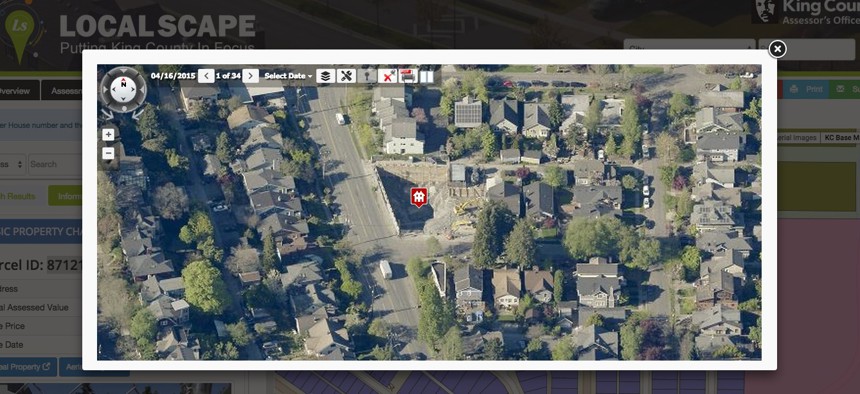With Localscape, a County Assessor Harnesses More Than Just Property Data

A new multi-family building will rise from this hole in the ground in Seattle's Montlake neighborhood. Localscape / King County Assessor's Office

Connecting state and local government leaders
King County Assessor Lloyd Hara once asked: ‘Why can’t we have a single platform for our information?’ Now, Seattle-area residents have easy access to location-specific information and a whole lot more.
SEATTLE — At the corner of 24th Avenue East and East Boston Street in the Montlake neighborhood near the University of Washington, there’s currently a big hole in the ground surrounded mostly by single-family homes.
Just like in so many other neighborhoods in Seattle, a new multi-family, mixed-use building will eventually take shape on the corner. The project isn’t really anything out of the ordinary for one of the nation's fastest-growing cities that’s at the center of booming regional tech economy.
Real estate, as a result, has been booming, too, so Seattle and its environs have been a fascinating petri dish to study property data.
Zillow, based downtown, has become a household name across the nation for bringing together real estate data on one platform and is certainly familiar to house-buying Seattleites. But a few blocks away from Zillow’s headquarters, one of the most recent interesting fusions of location-based data and property information has been taking shape in the office of King County Assessor Lloyd Hara.
This summer, Hara’s office unveiled Localscape, a new tool to examine not just property data for Seattle and its neighboring municipalities and unincorporated areas in King County, but a whole host of other data layers, including census, education, economic development and permitting information from local jurisdictions, like the city of Seattle.

It’s all available through mapping and aerial navigation, letting users easily explore the data that underlies their local environs through toggling and layering.
Before Localscape, all that information lived in separate places and it would have taken a lot of time and effort to piece it all together.
During a recent interview with Route Fifty in his office in the King County Administration Building, Hara, a former Seattle city treasurer and Seattle Port commissioner who has served as county assessor since being elected in 2009, said that before the idea for Localscape came together, he had wondered: “Why can’t we have a single platform for our information?”
So, with Localscape, “we laid it all out there,” Hara said, adding that it fits with his mission of being “as transparent and as accessible as possible.”
In the case of the corner lot under development in Montlake, you can pull up a history of permitting information, assessed property value and other site-specific information regarding the parcel in question, No. 8712100035.
Across the street, you can check out information for Seattle’s curious and very slender “Spite House,” which at 430 square feet, is most likely the neighborhood’s least-expensive parcel. The one-bedroom, one-bathroom residence was assessed at $254,000 and was sold in May 2014 for $375,000, according to Localscape.
But you can also explore the Montlake neighborhood as a whole with Localscape. By drawing an outline around a desired area of interest, in this case, the rough boundaries of Montlake, you can discover various information layers.

There’s roughly 3,200 people who live in the neighborhood, with the largest percentage age 25 to 64. There are 1,273 properties with a total appraised value of $875.19 million, the vast majority being residential properties, with an average residential appraisal coming in at nearly $688,000—a price that shouldn’t surprise anyone familiar with the Seattle area.
Examining demographic data for the neighborhood, the area has a vast majority of residents who are of non-Hispanic white heritage. Localscape also shows the area to be dominated by college graduates with 46.4 percent holding advanced degrees, which isn’t surprising considering the proximity to the University of Washington.
The neighborhood’s local elementary gets very high marks according to ratings by GreatSchools, which are integrated into the Localscape platform.
“Clearly from the homeowners’ standpoint, education data is extremely important,” Hara said.
It can also help local officials make better, data-driven decisions. Hara pointed to a local district fire chief in the community of Enumclaw, who recently wrote his office about the benefits of the Department of Assessments’ new data exploration platform.
“We were able to utilize Localscape in order to complete our twenty year capital facilities plan. Using Localscape, we were able to identify vacant properties zoned for either for commercial or residential. This helped us establish impact fees for new development which will significantly help out fire department meet the needs of our community for years to come,” Fire District 28 Chief Randy Fehr wrote in letter to Hara in September.
All in all, Localscape is a slick, integrated data-exploration platform. And while being a conduit for information like education rating data might not fit squarely under the core duties of a county assessor, Hara said it makes sense from an expanded customer service perspective.
And it’s a good model for other jurisdictions to emulate.
RELATED on Route Fifty: "A GPS-Enabled, One-Stop Shop for Everything Real Estate"
Michael Grass is Executive Editor of Government Executive’s Route Fifty.

NEXT STORY: Low Gas Prices Could Give Toll Roads a Financial Boost





